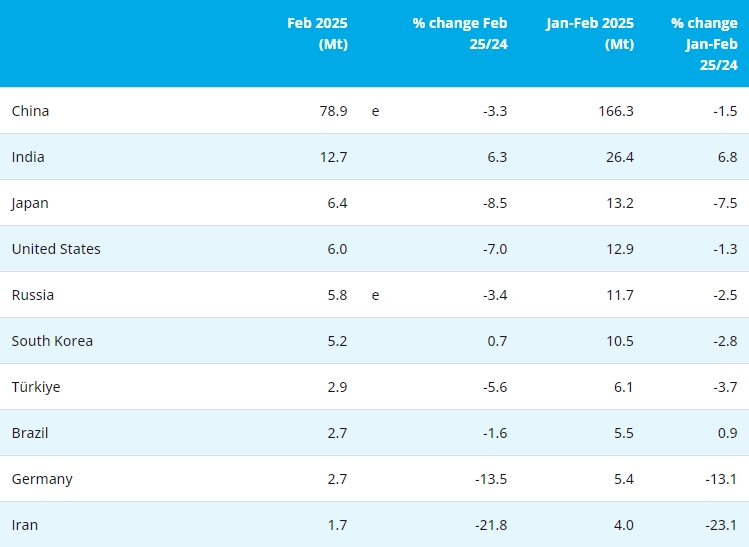[www.ferro-alloys.com] Chinese steel mills are becoming cleaner every month as Beijing pushes to curb its smoke-stack industries. But they’re not getting any leaner.
Despite efforts to step up environmental checks and trim out excess capacity, steel output by the world’s top producer has risen year-on-year for the past seven months.
As emissions cuts will mean steel mills are better able to meet stricter government standards, Beijing may find it more difficult to cut overcapacity in a sprawling industry.
For now, domestic demand from infrastructure and construction has been robust, absorbing most of the extra supply. But a steeper slowdown in the world’s second-largest economy could force mills to ramp up sales abroad.
That could rekindle tensions with Europe and the United States, major trading partners which have for years accused China of dumping its excess steel overseas, hitting producers and hurting global prices.
The issue took center stage at a recent G20 summit in China when world leaders pledged to work to address excess output.
China’s top steel producing city of Tangshan in Hebei province illustrates Beijing’s dilemma. Hosting a months-long international horticultural show, Tangshan had a major six-month clean-up to ensure blue skies for visiting dignitaries, including the country’s president Xi Jinping.
Industry experts predicted this would see a big drop in output in a province that accounts for a fifth of national production, going some way to realizing government goals on output and capacity cuts.
But production dipped by far less than expected as mills sustained output even as they cleaned themselves up.
They could do this largely because steel prices SRBcv1 have risen 40 percent this year, and strong domestic demand is expected to continue, underpinning those increases, though exports have fallen to their lowest since February.
By end-September, China had completed more than 80 percent of this year’s capacity reduction goals in coal and steel, said Huang Libin, an official at the Ministry of Industry and Information Technology.
China has targeted a cut of 45 million tonnes from its surplus steel capacity this year.
But the battle to tackle excess capacity and curb pollution has failed to dent production. China’s annual crude steel surplus is estimated at around 300 million tonnes, three times the annual output of the world’s second-biggest producer, Japan.
“If steel mills are profitable, there’s no reason for the government to order them to reduce production if they meet environmental criteria,” said Xia Junyan, investment manager at Hangzhou CIEC Trading Co in Shanghai.
BATTLEGROUND IN TANGSHAN
While many of Tangshan’s small mills have closed, bigger plants have installed or upgraded equipment since a nationwide environmental crackdown began in 2014, industry sources say.
Some were forced to cut sinter production – processing iron ore fines into lumps – for a few days in September and October to clear the skies during the recent horticultural show. But the city’s about 150 blast furnaces only dropped output three times – in June, July and September – and for only a couple of days during the six-month clean-up, according to a survey by industry consultancy Custeel.com.
The biggest drop was in early June when operating rates fell below 65 percent as leaders from central and eastern Europe gathered in Tangshan for talks on economic ties, followed by another fall in July as the city prepared to commemorate a 1976 earthquake that killed at least 250,000 people.
Otherwise, mills have been operating at above 80 percent of capacity this year, the Custeel.com survey showed.
“Production can be flexible. Even if production at steel mills is hit temporarily by the environmental crackdown, they can increase production later to offset the losses,” said Xia at Hangzhou CIEC Trading.
The government looks ready to keep targeting Tangshan’s mills in its war on winter smog, with Hebei province last week imposing what it calls “special emission restrictions” on local steel mills, according to a policy document.
Last month, the National Development and Reform Commission, China’s state planner, said it punished hundreds of steel and coal companies nationwide for violating environmental and safety regulations. Some were forced to close or cut output.
Source: Reuters (Reporting by Ruby Lian in SHANGHAI and Manolo Serapio Jr. in SINGAPORE; Editing by Josephine Mason and Ian Geoghegan)
**Article from Internet for reference only
- [Editor:tianyawei]



 Save
Save Print
Print Daily News
Daily News Research
Research Magazine
Magazine Company Database
Company Database Customized Database
Customized Database Conferences
Conferences Advertisement
Advertisement Trade
Trade




 Online inquiry
Online inquiry Contact
Contact

Tell Us What You Think